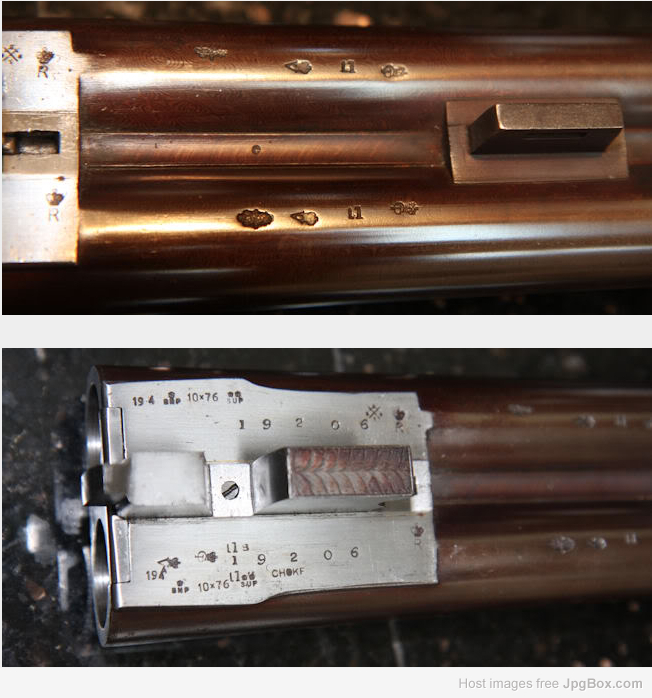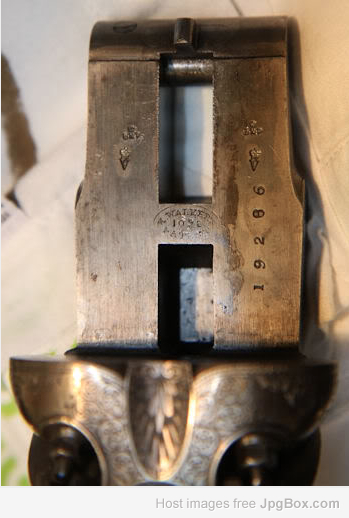Moses....good point and I really don't know. But I've seen some strange stuff on Reilly's....here is the post on 19286 where the board sort of decided the numbers on the action applied sort of reinforced by the trigger guard attenuated number (and to my mind the "8" on the action looks cramped and strange)....as opposed to the numbers on the barrels and forearm. Whatever...I'm going with the 27853....majority vote. If I can find 27854 and it has an engraved escutcheon..QED.
===================================Text from the Reilly Line=================================
https://www.doublegunshop.com/forums/ubbthreads.php?ubb=showflat&Number=436538&page=13Quote: The chat analysis...posted below...while confused like everybody who writes about Reilly by someone's claim (possible Brown?) that Reilly closed rue Scribe in 1872 and reopened it in 1884...results in a spot on conclusion - late 1874 or early 1875. I'll post the conversation here and photos because this is in a way some validation of the dating method and indicates the model is pretty darn accurate.
https://www.internetgunclub.com/archived-forum/posts.php?topicid=1344I am a new member to this excellent forum and would value some assistance on the aforementioned gun. A little bit of current information;
- 10 bore hammergun, rebounding hammers, breech face in good condition with no pitting; some relatively basic scroll engraving. Table reads "H Walker's 1098 Patent"
- 30 inch Damascus barrels, excellent condition with v minor exterior pitting in some areas. Game/concave rib, wedge and escutcheon fore-end; recently nitro-proofed
- Semi pistol grip stock with original heel plate; some minor marking and one small (1cm) chip out of stock close to action.
Confusingly, the gun has a slight difference in serial numbers; the table reads 19286, the barrels and foreend 19206, the trigger guard 1928 – could the table be a mistaken number? Any help on assessing what the proof marks mean would be most helpful!
Guidance on history, originality and possible value would be greatly appreciated. I would like to use the gun ongoing for ‘fowling so am genuinely keen to find out more. A brief review of the history of Reilly could indicate manufacture between 1869-1872 (due to Paris address), but happy to be proven wrong here.
++++++++++++++response from “Tiger” (hope Lagopus or some of the other UK members known him - the response is excellent)++++++++++++++++++
As far as we know, the Reillys, like most gunmakers, bought the various components and assembled them, or bought almost complete guns "in-the-white", stocked and finished them, and put their name on them. Although this gun has London proof marks, all of it is likely to have been made in Birmingham. Nothing wrong with that, good servicable weapons of better quality than anywhere else in the world for the price. The "Best" quality in a London gun came mainly from the final finishing which added a little to reliability and "feel" but most to beauty / elegance and pride of ownership.
Your gun was a nominal 10 bore but actually measured 11 bore. Lovely damascus barrels bearing the crown over V London View Mark (1637-1954) for preliminary inspection, the crown over bar over GP Provisional Proof Mark (1813-date) to reveal faults before any expensive work was done on the barrels, and the crown over GP London Definitive Proof Mark (1637 to date), all these adding up to Black Powder Proof. The barrel flats have two of these original marks as expected.
The action flats have the expected View mark, and they have the H Walker patent mark for his barrel bolting and safety for drop-down actions patent No 455 of 12 February 1872 ( Use No. 1098 ) .
Of equal importance to the marks are the ones that don't appear e.g. no NOT FOR BALL or CHOKE mark (so see what patterns it throws with various cartridges). The first of these was introduced in 1875, so this and the patent date mean the gun was made definitely not before Feb 72, or after 1875.
It must have been made a couple of years after 1872, say 1874 to early 1875, and we favour the latter because even if the gun was made by a large trade maker, the 1098 use number is quite a large number. You will have noted that neither we nor anyone else really know when the Paris shop closed, we only think it was shortly after 1872.
The gun was re-proved after 2005, we can't read the crossed swords date code and confess to not having the key to these recent codes! The two crowns over SUP are for the Superior Proof Mark for 1200 Bars, 10x76 is 10 bore 76mm chambers; 19.4 is the barrel diameter and crown over BNP is the Birmingham Nitro Proof Mark. Crown over R is the re-proof mark - why it is deemed necessary we don't know!
We think you can take it that the serial number is 19286 and that the engraver was an old man with poor eyesight and and a bad memory. Unlike the other gun we mentioned, we don't think this gun is made up of muddled parts! 
